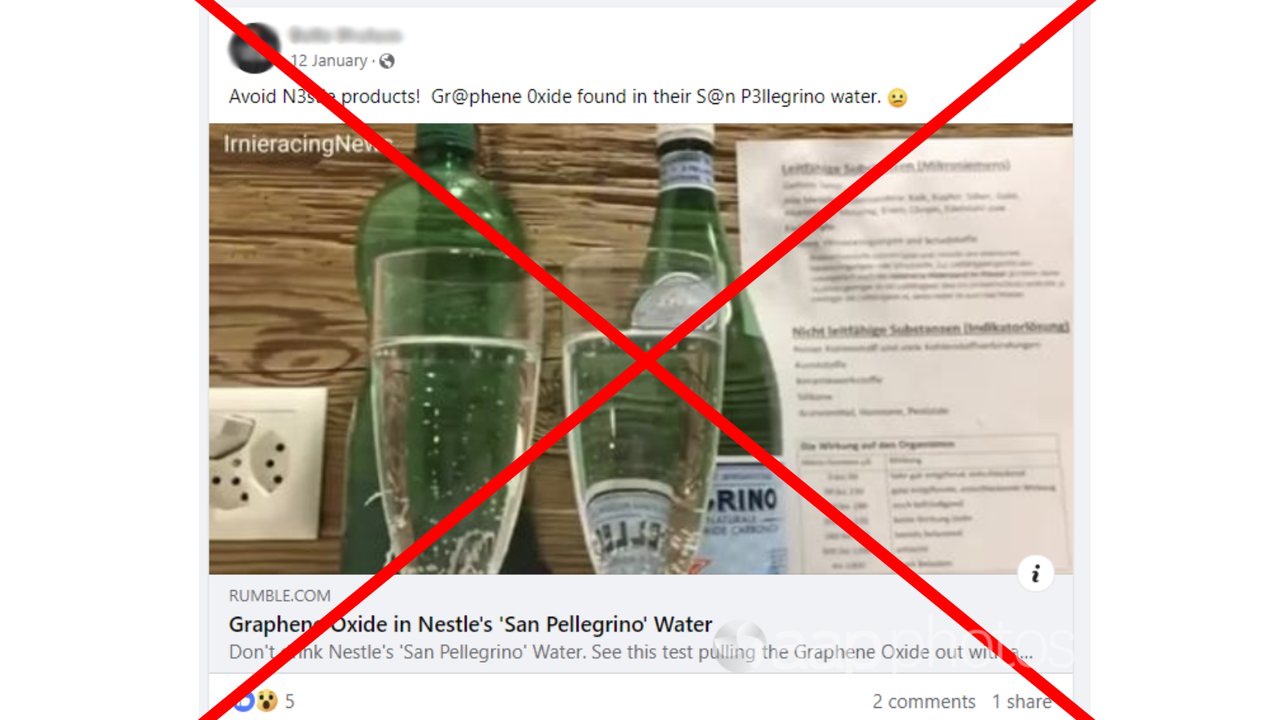AAP FACTCHECK – An experiment reveals San Pellegrino sparkling water contains graphene oxide, social media users are claiming.
This is false. Experts told AAP FactCheck such a conclusion cannot be drawn from the experiment and the resulting substance is likely some form of iron from the electrodes plunged into the water.
The claim is made in multiple social media posts, with some dating back to at least 2021.
The posts feature a video in which a man appearing to speak German performs a test comparing two bottles of water, one of them Nestle’s San Pellegrino.
He places an electrolyser, a device which uses electricity to separate water’s hydrogen and oxygen components, into the two products.
At the 3min 50secs mark, the video shows the water in each glass has discoloured, and then at 4min 17secs there’s what appears to be sediment in the bottom of both.

The man then holds what appears to be a magnet next to the glass containing the other sparkling water product, and the sediment stays at the bottom of the glass.
He then does the same to the glass of San Pellegrino, and the sediment follows the magnet.
This is claimed as proof the product contains the material graphene oxide, which is the oxidised form of graphene.
This material has gained notoriety thanks to false claims that it’s a hidden ingredient in COVID-19 vaccines, which have been widely debunked.
Professor William Alexander Donald, of the University of NSW’s School of Chemistry, said there was no scientific basis for the claim.
He explained that the formation of the sediment, or precipitate, in the water doesn’t mean this was in the water beforehand, “but rather that it was formed under extreme conditions that the water is not normally subjected [to]”.
The video’s claim that the magnetic sediment is graphene oxide “lacks any scientific basis,” Prof Donald added.
“Without thorough analysis and characterisation using appropriate techniques, it’s challenging to conclusively identify the composition and origin of the observed magnetic residues.
“So any claims that the water is not safe to drink because an unknown residue is formed during electrolysis, cannot be substantiated using the approach in the video.”
Professor Yuan Chen, director of the Advanced Carbon Research Lab at the University of Sydney, said it was not possible that the substance was graphene oxide.
“Graphene oxide is mainly comprised of carbon,” Prof Chen told AAP FactCheck.
“Creating solid carbon materials from water, even with metal ions, is impossible.”
He said it was likely the magnetic residues were some form of iron from the electrodes placed into the water.
“Mineral water is more conductive,” he said, “thus, iron electrodes are more corroded.”
AAP FactCheck previously debunked claims that an electrolyser can be used to assess “impurities” in bottled water.
Experts also said that changes to water quality were likely the result of a reaction involving iron from the electrode.
In August, 2022, Nestle responded to a post on X, formerly Twitter, about the San Pellegrino video to say the claim was not correct.
“We wish to be very clear that this video and ‘experiment’ is fake news. There is no truth in it. S.Pellegrino /our Natural mineral waters do not contain Graphene Oxide, so it cannot be ‘revealed’ by this experiment.”
The Verdict
False — The claim is inaccurate.
AAP FactCheck is an accredited member of the International Fact-Checking Network. To keep up with our latest fact checks, follow us on Facebook, Twitter and Instagram.
All information, text and images included on the AAP Websites is for personal use only and may not be re-written, copied, re-sold or re-distributed, framed, linked, shared onto social media or otherwise used whether for compensation of any kind or not, unless you have the prior written permission of AAP. For more information, please refer to our standard terms and conditions.


















